Exercise-5.1 : Introduction to Euclids Geometry - Class 9 PDF Download
Exercise-5.1
Question 1: Which of the following statements are true and which are false? Give reasons for your answers.
- Only one line can pass through a single point.
- There are infinite numbers of lines which pass through two distinct points.
- A terminated line can be produced indefinitely on both the sides.
- If two circles are equal, then their radii are equal.
- In the following figure, if AB = PQ and PQ = XY, than AB = XY.

Answer: (1) False. As we know that there are various points in a plane. Such that A, B, C, D AND E. Now by first postulate we know that a line may be drawn from a given point to another point.
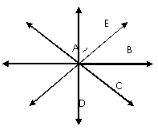
So, we can draw a line from A to B, A to C, A to D, and A to E. It proves that many lines can pass through point A.
Hence, we conclude that infinite lines can pass through a single point.
Answer: (2) False.
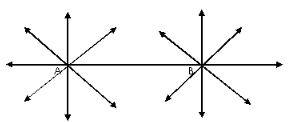
Let us mark two points A and B on the plane of paper. Now we fold the paper so that a crease passes through A. Since we know that an unlimited number of lines can pass through a point. So an unlimited number of lines can pass through A.
Again we fold the paper so that a line passes through B. Clearly infinite number of lines can pass through B. Now we fold the paper in such a way that a line passes through both A and B.
We observe that there is just only one line passing through both A and B.
Answer: (3) True, In geometry, by a line, we mean the line in its totality and not a portion of it. A physical example of a perfect line is not possible. Since a line extends indefinitely in both the directions.

So, it cannot be drawn or shown whole on paper. In practice, only a portion of a line is drawn and arrowheads are marked at its two ends indicating that it extends indefinitely in both directions.
Answer: (4) True, on super imposing the region bounded by one circle on the other if the circle coincides. Then, their centres and boundaries coincide. Therefore, their radii will be equal.
Answer: (5) True, because things which are equal to the same thing, are equal to one another.
Question 2: Give a definition for each of the following terms. Are there other terms that need to be defined first? What are they how might you define them?
(1)parallel lines (2) perpendicular lines (3) line segment (4) radius of a circle (5) square
Answer: To define the terms given in the question we need to define the following terms first.
(a) Point: A small dot made by sharp pencil on a sheet of paper gives an idea about a point. A point has no dimension, it has only position.
(b) Line: A line is the set of points which has length only and no breadth. The basic concept about a line is that it should be straight and that it should extend indefinitely in both the directions.
(c) Plane: The surface of a smooth wall or the surfaces of a sheet of paper are close examples of a plane.
(d) Ray: A part of line l which has only one end-point A and contains the point B is called a ray AB.
(e)Angle: An angle is the union of two non-collinear rays with a common initial point.

(f) Circle: A circle is the set of all those points in a plane whose distance from a fixed point remains constant. The fixed point is called the centre of the circle.
OA = OB = OC = radius
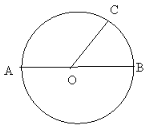
(g) Quadrilateral: A closed figure made of four line segments is called a quadrilateral.

(1) Parallel Lines: Two lines are said to be parallel when (a) They never meet or never intersect each other even if they are extended to the infinity. (b) they coplanar.

In figure, the two lines m and n are parallel.
(2) Perpendicular lines: Two lines AB and CD lying on the same plane are said to be perpendicular, if they form a right angle. We write AB ┴ CD.
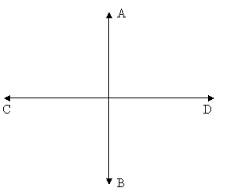
(3)Line-segment: A line-segment is a part of line. When two distinct points, say A and B on a line are given, then the part of this line with end-points A and B is called the line-segment.

It is named as AB, AB AND BA to denote the same line-segment.
(4)Radius: The distance from the centre to a point on the circle is called the radius of the circle. In the following figure OP is the radius.
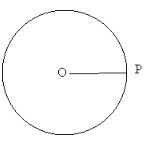
(5)Square: A quadrilateral in which all the four angles are right angles and four sides are equal is called a square. ABCD is a square.

Question 3: Consider the two ‘postulates’ given below:
(i)Given any two distinct points A and B, there exists a third point C which is in between A and B.
(ii) There exist at least three points that are not on the same line.
Do these postulates contain any undefined terms? Are these postulates consistent?
Answer: There are several undefined terms which we should keep in mind. They are consistent, because they deal with two different situations:
(i) says that the given two points A and B, there is a point C lying on the line in between them;
(ii) says that given A and B, we ca take C not lying on the line through A and B.
These ‘postulates’ do not follow from Euclid’s postulates. However, they follow from axiom stated as given two distinct points; there is a unique line that passes through them.
Question 4: If point C lies between two points A and B such that AC = BC, then prove that AC = 1/2 AB. Explain by drawing the figure.
Answer: Given AC = BC ………………..equation (i)

From equation (i)
AC = BC
Or, AC + AC = BC + AC {adding AC on both the sides}
Or, 2AC = AB {because BC + AC = AB}
AC = 1/2 AB
Question 5: In Question 4, point C is called a mid-point of line-segment AB. Prove that every line-segment has one and only one mid-point.

Given, AC = BC ………………..equation (i)
If possible let D be another mid-point of AB.
AD = DB ………………….equation (ii)
Subtracting equation (ii) from equation (i)
AC –AD = BC – DB
Or, DC = -DC {because AC-AD = DC and CB-DB = -DC}
Or, DC + DC = 0
Or, 2DC = 0
Or, DC = 0
So, C and D coincide.
Thus, every line-segment has one and only one mid-point.
Question 6: In the following figure, if AC = BD, then prove that AB = CD

Answer: Given, AC = BD ………………..equation (i)
AC = AB + BC ……equation (ii) {Point B lies between A and C}
Also BD = BC + CD …… equation (iii) {Point C lies between B and D}
Now, substituting equation (ii) and (iii) in equation (i), we get
AB + BC = BC + C
AB + BC – BC = CD
AB = CD
Hence, AB = CD.
Question 7: Why is Axiom 5, in the list of Euclid’s axioms, considered a ‘universal truth’? (Note that the question is not about the 5th postulate).
Answer: Axiom 5 in the list of Euclid’s axioms is true for any thing in any part of universe so this is a universal truth.
FAQs on Exercise-5.1 : Introduction to Euclids Geometry - Class 9
| 1. What is Euclid's Geometry and why is it important? |  |
| 2. Who is Euclid and what is his contribution to geometry? |  |
| 3. What are the basic elements of Euclidean geometry? |  |
| 4. What are Euclidean postulates? |  |
| 5. How is Euclidean geometry different from non-Euclidean geometry? |  |




















